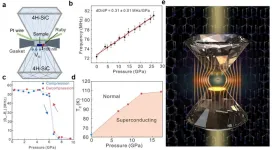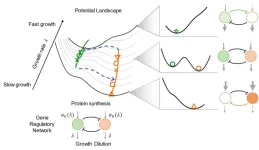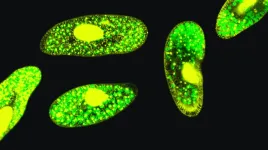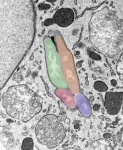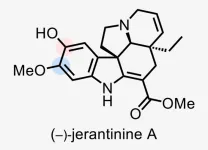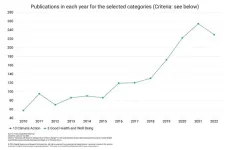(Press-News.org) A research study has shed new light on how congenital muscular dystrophies such as Walker-Warburg syndrome progress, bringing hope for better understanding, early diagnosis and treatments of these fatal disorders.
Published in March in the Journal of Biological Chemistry, the research was led by scientists in the lab of Vlad Panin, Ph.D., professor in the Department of Biochemistry and Biophysics in the Texas A&M College of Agriculture and Life Sciences. The study is titled “Protein tyrosine phosphatase 69D is a substrate of protein O-mannosyltransferases 1-2 that is required for the wiring of sensory axons in Drosophila.” The primary author is Pedro Monagas-Valentin, one of Panin’s doctoral students.
The study uncovers new ways of how genetic mutations seen in patients with muscular dystrophies may lead to disease and create neurological problems. Namely, the mutations disrupt a newly discovered gene function and prevent neurons from forming connections properly. The research used fruit flies as a model system and has implications for humans.
Funders of the research included the National Institutes of Health and the Texas A&M AgriLife Institute for Advancing Health Through Agriculture.
Walker-Warburg syndrome and other muscular dystrophies
Walker-Warburg and muscle-eye-brain syndromes are rare, severe muscular dystrophies. Typically diagnosed in very young children, these conditions progress rapidly. They affect skeletal, heart and lung muscles as well as the brain, eyes and other organs. No cure exists for these diseases, and patients usually do not survive into adulthood.
“Certain genes affected in these disorders are known,” Panin said. “But much remains unknown about how these genetic defects affect molecular and cellular processes to cause neurological and other problems.”
This gap in understanding of pathological mechanisms impedes the development of treatments and efficient diagnostics, he said.
A problem tied to sugar biology
Many of the genetic mutations that occur with muscular dystrophies affect something difficult to study, Panin said, and that is the way our bodies build and use complex sugars.
The sugars, called glycans, are made by all living things. In addition to energy storage and regulation, glycans have countless functions that regulate other molecules in animal cells.
“There are four ‘languages’ of life, if you think about it in general,” Panin said. “Two are proteins and nucleic acids like DNA and RNA. And there are two more languages: lipids and glycans. The fourth one is arguably the most complex ‘language,’ and this is what we study as glycobiologists.”
Glycans can be complex and branching. Unlike DNA or proteins, they are not created from a genetic template. The mutations in muscular dystrophy patients disturb a complex chain of events needed to build and attach glycans to the right molecules inside our bodies. To understand that chain of events, scientists must study the structures and locations of glycans, and the technology to do that is still being developed.
What the team did
To track the role of several genetic mutations in muscular dystrophies, the team genetically modified fruit flies, then studied how the mutations affected the flies’ nervous system structure and glycobiology.
“My work involved a lot of crossing different lines of fruit flies to either raise or lower the activity of genes we wanted to learn more about,” Monagas-Valentin said. “Then I did a lot of fly brain dissections under the microscope, of multiple genetic combinations, with a lot of practice and a lot of messing up.”
Monagas-Valentin used fluorescence microscopy and other methods to compare how different mutations in flies affected fly bodies and brains. He also sent samples for analysis using methods specifically designed for glycobiology. For that analysis, Monagas-Valentin and Panin collaborated with researchers at the Complex Carbohydrate Research Center at the University of Georgia in Athens.
“Our collaborators have expertise in glycan sample preparation, data analysis, protocol development — every step is important,” Panin said.
Putting all the data together, the team found that a protein called PTP69D enables the proper wiring of sensory axons in flies. The researchers also revealed that the genes mutated in muscular dystrophy patients are important for PTP69D to function properly. What’s more, PTP69D belongs to a large family of proteins that have very similar structure and function in flies and humans.
“This story opens up new directions to understand neurological problems,” Panin said.
What’s next
Although PTP69D and its protein family members are similar in flies and in humans, there are limitations to what the present study says about human biology, Panin said.
“The fly nervous system is much simpler, and in humans there may be additional protein and glycan interactions in play,” Panin said. “We can see the basic mechanisms, but nuances and additional layers cannot be studied in flies.”
He said much is still unknown about the proteins and glycans involved in neuron development. The team will now study these molecules and interactions more deeply to see how mutations in muscular dystrophy genes affect individual neurons.
-30-
END
Study uncovers aspect of how muscular dystrophies progress
Advance has potential for early diagnosis, treatments of Walker-Warburg syndrome, other muscular dystrophies
2023-03-23
ELSE PRESS RELEASES FROM THIS DATE:
Researchers make breakthrough in high-pressure magnetic detection
2023-03-23
According to a study published in Nature Materials, a collaborative research team from the Hefei Institutes of Physical Science of the Chinese Academy of Sciences (CAS) and the University of Science and Technology of China has developed a research platform to study superconducting magnetic detection and magnetic phase transitions of hydrides under high pressure.
High-resolution in-situ magnetic measurement under high pressure has been a challenge. It has limited the progress of research on the Meissner effect of superconductivity and on magnetic phase transition behavior under high pressure. Using the optically detected ...
Cellular growth rate reshapes cell-fate-decision landscape
2023-03-23
Genes and the regulation relationships among them create complex networks that determine cell differentiation trajectories. However, we still cannot understand and predict the cell-fate-decision process using network topology in a bottom-up manner.
Recently, a research group led by Prof. FU Xiongfei from the Shenzhen Institute of Advanced Technology (SIAT) of the Chinese Academy of Sciences (CAS) has revealed how the global regulation factor, cellular growth rate, reshapes the cell-fate-decision landscape.
The ...
Where does your brain want to have lunch?
2023-03-23
New research published by investigators at Cedars-Sinai advances scientific understanding of how the brain weighs decisions involving what people like or value, such as choosing which book to read, which restaurant to pick for lunch—or even, which slot machine to play in a casino. Published today in the peer-reviewed journal Nature Human Behaviour, this study involved recording the activity of individual human neurons.
The study examined decisions called value-based choices, where there is ...
Microplastics limit energy production in tiny freshwater species
2023-03-23
Microplastic pollution reduces energy production in a microscopic creature found in freshwater worldwide, new research shows.
Paramecium bursaria contain algae that live inside their cells and provide energy by photosynthesis.
The new study, by the University of Exeter, tested whether severe microplastic contamination in the water affected this symbiotic relationship.
The results showed a 50% decline in net photosynthesis – a major impact on the algae’s ability to produce energy and release ...
SwRI, JPL study suggests explanation for unusual radar signatures of icy satellites in the outer solar system
2023-03-23
SAN ANTONIO — March 23, 2023 —A study co-authored by Southwest Research Institute Senior Research Scientist Dr. Jason Hofgartner explains the unusual radar signatures of icy satellites orbiting Jupiter and Saturn. Their radar signatures, which differ significantly from those of rocky worlds and most ice on Earth, have long been a vexing question for the scientific community.
“Six different models have been published in an attempt to explain the radar signatures of the icy moons that orbit Jupiter and Saturn,” said Hofgartner, first author of the study, ...
Harnessing power of immune system may lessen reliance on antibiotics for infections like TB
2023-03-23
Francis Crick Institute press release
Under strict embargo: 16:00 GMT 23 March 2023
Peer reviewed
Experimental study
Human stem cells
Researchers at the Francis Crick Institute have found that the body’s process of removing old and damaged cell parts, is also an essential part of tackling infections that take hold within our cells, like TB.
If this natural process can be harnessed with new treatments, it could present an alternative to, or improve use of antibiotics, especially where bacteria have become ...
Newly discovered cell in fruit flies is essential for touch sensation
2023-03-23
The Francis Crick Institute press release
Under strict embargo: 16:00 GMT Thursday 23rd March
Peer reviewed
Experimental
Cells
Researchers at the Francis Crick Institute have uncovered a key role for a new type of cell in touch detection in the skin of the fruit fly.
Touch allows animals to navigate their environment by gathering information from the outside world. In their study published today in Nature Cell Biology, Dr Federica Mangione and Dr Nicolas Tapon shed light on how touch-sensitive organs assemble during development.
In particular the team studied the development ...
Researchers discover a way to fight the aging process and cancer development
2023-03-23
A protein complex prevents the repair of genome damage in human cells, in mice and in the nematode Caenorhabditis elegans, a team of researchers at the University of Cologne has discovered. They also successfully inhibited this complex for the first time using a pharmaceutical agent.
“When we suppress the so-called DREAM complex in body cells, various repair mechanisms kick in, making these cells extremely resilient towards all kinds of DNA damage,” said Professor Dr Björn Schumacher, Director of the Institute for Genome Stability in Aging ...
A new, sustainable source for a promising cancer killer
2023-03-23
Plants produce all types of curious chemicals. Some deter predators. Some smell wonderful. Some even have medicinal value. One of these hidden gems is (–)-jerantinine A (JA), a molecule with remarkable anticancer properties, produced by a plant called Tabernaemontana corymbosa. Unfortunately, access to this Malaysian jungle plant and its promising chemical compound has been limited. Until now.
Cold Spring Harbor Laboratory (CSHL) chemists, led by Professor John E. Moses, have created a way to safely, quickly, and sustainably synthesize JA in the lab. To cancer biologists at CSHL, this breakthrough could mean future ...
Disparities in the research effort to combat animal-borne diseases amid climate change
2023-03-23
Whether it’s diseases from bats, birds, pigs, or mosquitoes, climate change brings with it an increased risk of animal-borne (or “zoonotic”) diseases that can transmit to humans.
Digital Science, a technology company serving stakeholders across the research ecosystem, has today released its analysis of the global research response to climate change and zoonotic diseases, in the context of the United Nations’ Sustainable Development Goals (SDGs) on climate and health.
Using data from Dimensions, Dr Briony Fane, Ann Campbell and Dr Juergen Wastl from Digital Science have explored published research, ...
LAST 30 PRESS RELEASES:
Research validates laboratory model for studying high-grade serous ovarian cancer
SIR 2026 delivers transformative breakthroughs in minimally invasive medicine to improve patient care
Stem Cell Reports most downloaded papers of 2025 highlight the breadth and impact of stem cell research
Oxford-led study estimates NHS spends around 3% of its primary and secondary care budget on the health impacts of heat and cold in England
A researcher’s long quest leads to a smart composite breakthrough
Urban wild bees act as “microbial sensors” of city health.
New study finds where you live affects recovery after a hip fracture
Forecasting the impact of fully automated vehicle adoption on US road traffic injuries
Alcohol-related hospitalizations from 2016 to 2022
Semaglutide and hospitalizations in patients with obesity and established cardiovascular disease
Researchers ‘listen in’ to embryo-mother interactions during implantation using a culture system replicating the womb lining
How changing your diet could help save the world
How to make AI truly scalable and reliable for real-time traffic assignment?
Beyond fragmented markets: A new framework for efficient and stable ride-pooling
Can shape priors make road perception more reliable for autonomous driving?
AI tracks nearly 100 years of aging research, revealing key trends and gaps
Innovative techniques enable Italy’s first imaging of individual trapped atoms
KIER successfully develops Korea-made “calibration thermoelectric module” for measuring thermoelectric device performance
Diversifying US Midwest farming for stability and resilience
Emphasizing immigrants’ deservingness shifts attitudes
Japanese eels, climate change, and river temperature
Pusan National University researchers discover faster, smarter heat treatment for lightweight magnesium metals
China’s 2024 Gastroenterology Report: marked progress in endoscopy quality and disease management
Pusan National University researchers uncover scalable method for ultrahigh-resolution quantum dot displays
Researchers use robotics to find potential new antibiotic among hundreds of metal complexes
Gut bacteria changes at the earliest stages of inflammatory bowel disease
Scientists develop new way to “listen in” on the brain’s hidden language
Brain research: “Pulse generators” grow and shrink as memories are formed
For teens, any cannabis use may have impact on emotional health, academic performance
School meals could unlock major gains for human and planetary health
[Press-News.org] Study uncovers aspect of how muscular dystrophies progressAdvance has potential for early diagnosis, treatments of Walker-Warburg syndrome, other muscular dystrophies
